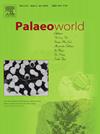Chemostratigraphy of Albian deposits in northern Tunisia: Identification of early Albian Oceanic Anoxic Event in the southern Tethys
IF 1.7
3区 地球科学
Q2 PALEONTOLOGY
引用次数: 0
Abstract
An integrated analysis of multiple geochemical proxies, including δ13Corg, total organic carbon (TOC), trace elements, and chemical gamma ray, coupled with a microfacies study and an age calibration using planktonic foraminiferal markers, was conducted at the Ain Asker section in northern Tunisia. This study provides significant insights into the depositional and paleoenvironmental dynamics of the mid-Cretaceous.
The carbon isotopic excursions observed at the Ain Asker section reflect a notable increase in the burial rate of marine organic carbon, specifically confined to the middle part of the Microhedbergella rischi biozone. TOC values recorded from the F2-ASK unit reach up to 2.3% combined with a δ13Corg values reaching -24.49‰, suggesting substantial accumulation of decayed marine organic matter. Although full anoxic conditions were not prevalent during deposition, evidence of oxygen-depleted bottom waters is clearly supported by the distribution patterns of redox-sensitive trace elements, such as vanadium and nickel. These findings underscore the role of partial oxygen restriction in facilitating organic matter preservation.
The enhanced burial of organic carbon is attributed to increased nutrient influx, likely driven by global sea-level transgressions and heightened surface productivity. These processes created favorable conditions for organic matter production and preservation. The integration of these sedimentological and geochemical findings with comparative records from Europe (France and Italy), China, and Mexico enables reliable correlation with the Paquier black shale level, a hallmark of OAE1b.
The Ain Asker section, through its detailed geochemical and isotopic signatures, emerges as a critical reference section for unraveling mid-Cretaceous anoxia dynamics within the southern Tethyan Realm. Its study enhances our understanding of the interplay between global paleoceanographic events and local depositional processes, shedding light on the mechanisms of organic carbon burial during a pivotal period in Earth’s history.
突尼斯北部Albian沉积物的化学地层学:特提斯南部早期Albian海洋缺氧事件的鉴定
对突尼斯北部Ain Asker剖面进行了δ13Corg、总有机碳(TOC)、微量元素和化学伽马等多种地球化学指标的综合分析,并结合微相研究和利用浮游有孔虫标记物进行了年龄标定。该研究对中白垩世沉积和古环境动力学具有重要意义。在Ain Asker剖面观测到的碳同位素偏移反映了海相有机碳埋藏速率的显著增加,特别是局限于Microhedbergella rischi生物带中部。F2-ASK单元TOC值高达2.3%,δ13Corg值达-24.49‰,表明海相有机质大量聚集。尽管在沉积过程中完全缺氧的条件并不普遍,但氧化还原敏感的微量元素(如钒和镍)的分布模式清楚地支持了底水缺氧的证据。这些发现强调了部分限氧在促进有机物保存中的作用。有机碳埋藏的增强可归因于营养物质流入的增加,这可能是由全球海平面海侵和地表生产力提高所驱动的。这些过程为有机质的产生和保存创造了有利条件。将这些沉积学和地球化学发现与欧洲(法国和意大利)、中国和墨西哥的比较记录相结合,可以与Paquier黑色页岩水平(OAE1b的标志)进行可靠的对比。Ain Asker剖面通过其详细的地球化学和同位素特征,成为揭示特提斯王国南部白垩纪中期缺氧动力学的关键参考剖面。它的研究增强了我们对全球古海洋事件与局部沉积过程之间相互作用的理解,揭示了地球历史上关键时期有机碳埋藏的机制。
本文章由计算机程序翻译,如有差异,请以英文原文为准。
求助全文
约1分钟内获得全文
求助全文
来源期刊

Palaeoworld
PALEONTOLOGY-
CiteScore
4.00
自引率
5.90%
发文量
95
期刊介绍:
Palaeoworld is a peer-reviewed quarterly journal dedicated to the study of past life and its environment. We encourage submission of original manuscripts on all aspects of palaeontology and stratigraphy, comparisons of regional and global data in time and space, and results generated by interdisciplinary investigations in related fields. Some issues will be devoted entirely to a special theme whereas others will be composed of contributed articles. Palaeoworld is dedicated to serving a broad spectrum of geoscientists and palaeobiologists as well as serving as a resource for students in fields as diverse as palaeobiology, evolutionary biology, taxonomy and phylogeny, geobiology, historical geology, and palaeoenvironment.
Palaeoworld publishes original articles in the following areas:
•Phylogeny and taxonomic studies of all fossil groups
•Biostratigraphy, chemostratigraphy, chronostratigraphy
•Palaeoecology, palaeoenvironment and global changes throughout Earth history
•Tempo and mode of biological evolution
•Biological events in Earth history (e.g., extinctions, radiations)
•Ecosystem evolution
•Geobiology and molecular palaeobiology
•Palaeontological and stratigraphic methods
•Interdisciplinary studies focusing on fossils and strata
 求助内容:
求助内容: 应助结果提醒方式:
应助结果提醒方式:


